By Nati Burnside
Anyone who has been paying attention recently would be able to tell you that tourism in the Jewish community is on the rise. There are cruises all over the world that provide kosher food, all-inclusive hotels with minyanim over Shabbat exist in a handful of foreign locations, and you can find a Chabad house in virtually every corner of the earth.
But while all those options are amazing, vacation doesn’t need to include a kosher cruise. Don’t be afraid to keep it simple and do something that would’ve been possible a decade or two ago.

Sports tourism is on the rise worldwide. It’s an industry worth almost $600 billion annually. And, while much of that is people going to big events like the Super Bowl or the World Cup, you can have a great time enjoying a couple of regular season baseball games. Fill out your schedule with a few other noteworthy spots and you’ve got yourself a memorable trip for a reasonable price compared to trying to snag tickets to the Olympics.
This article is a guide to a sports-themed trip to Missouri, but feel free to do your own research and make up a trip of your own. Most cities that have professional sports teams have a Jewish community big enough to be of help when you’re traveling.
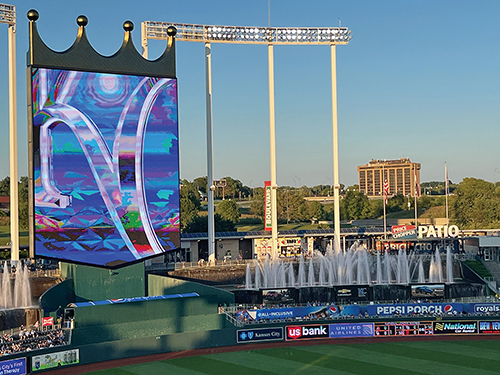
One of the reasons Missouri makes for a good destination is it’s fairly centrally located in the United States. Air travel is necessary given the distance from most other cities, but it’s close enough that the flights aren’t too long. My itinerary had me flying into St. Louis (flights are between 2 1/2 and 3 hours from New York City) and landing in the early afternoon. But before your plane even touches the ground, you might be able to see what should be your first stop after landing.
The Gateway Arch is the tallest national monument in the country. At 630 feet tall, the stainless steel structure was built in the 1960s in tribute to the westward expansion of the United States. It’s located in what is now called Gateway Arch National Park, adjacent to the Mississippi River in downtown St. Louis.
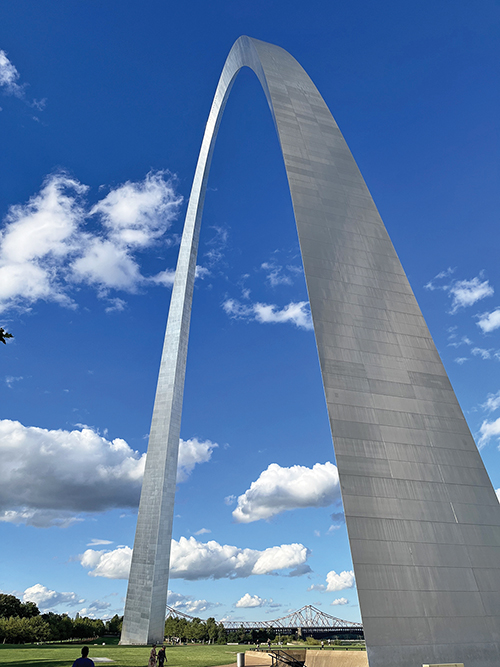
What does the arch have to do with sports? Not much, but you simply can’t visit St. Louis and not visit the incredible sight. However big you think it is, it looks bigger. In fact, it’s so tall that if you stand under it and look up, you will likely witness an optical illusion that makes it seem like the arch is moving and the clouds are stationary. It’s truly amazing.
There is a structure built underground at the base of the monument that houses many things to do. The museum will teach you everything you need to know about how St. Louis became the “Gateway to the West,” a documentary about the arch’s design and construction, a new virtual reality experience will transport you back to 1850, and even a riverboat cruise that provides unique views of the arch and downtown St. Louis.
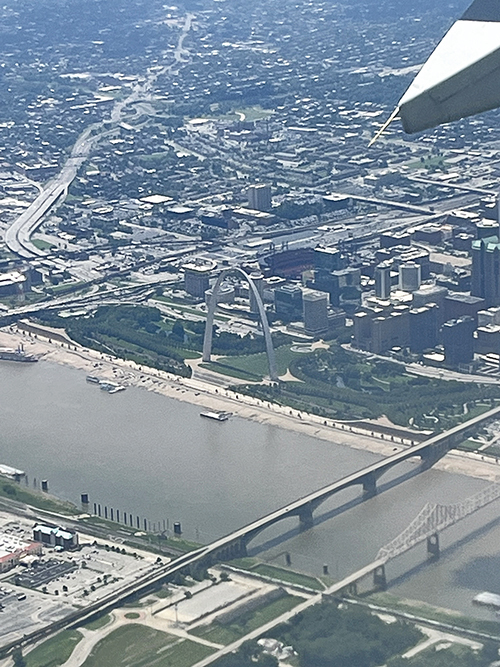
But if you are working with limited time, the Tram Ride to the Top is something you can’t miss. You’ll get to go to the top of the arch and look out at the city of St. Louis. The view is one that you won’t soon forget.
One of the places that you’ll be able to see from the top is Busch Stadium, the home of the St. Louis Cardinals. After leaving the arch, the ballpark is only a few blocks walk, so you won’t have to move your car from where you parked it earlier. The area around the stadium is called Ballpark Village and you’ll find a really great vibe on game day. There are multiple shops where you can find different types of souvenirs, including one that specializes in game-used items.

One of the most interesting elements of Ballpark Village is the St. Louis Cardinals Hall of Fame and Museum. With such a strong history, the Cardinals are one of a handful of teams that have their own stand alone museum outside the ballpark. Get to the stadium with enough time to spend an hour or so here. Not only are there multiple elaborate displays, like a room with memorabilia from every Cardinals World Series championship team (11 of them, going back to 1926) and a wall with every Cardinals bobblehead ever produced, but they also have a exhibit where you can try on a World Series ring or lift the bat of a Hall of Famer (provided you wear gloves).
Before heading into the stadium, you might want to swing by the statues outside. With such a storied history, the statues are numerous. With a dozen bronze figures representing the history of baseball in St. Louis, this is one of the most impressive collections of its kind in all of sports.
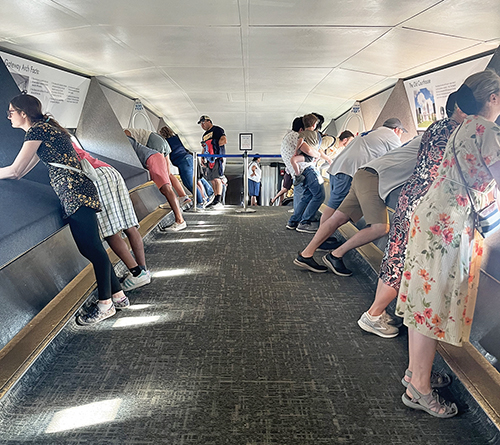
Busch Stadium is a fine stadium that is mostly known for the view of the arch (it can be seen behind the outfield). It opened in 2006 and is one of the “retro-classic” style ballparks, a tribute to Oriole Park at Camden Yards in Baltimore. There’s a reason that style was often imitated. The park has a clean, modern feel, but also gives the impression that you’re enveloped in the American pastime.
One thing that you certainly want to check out is the stadium cart by Kohn’s Kosher. The deli itself (located at 10405 Old Olive Street Rd.) was founded 60 years ago and is a staple of the Jewish community in the area and the only kosher meat restaurant in town. You might be asking how a community with only one kosher fleishig restaurant is able to support a stand in the stadium. The cart is actually very popular with all types of fans (maybe not vegetarians), kosher-keeping or otherwise. In fact, their offerings have been featured in some online lists about the best ballpark food around the country.
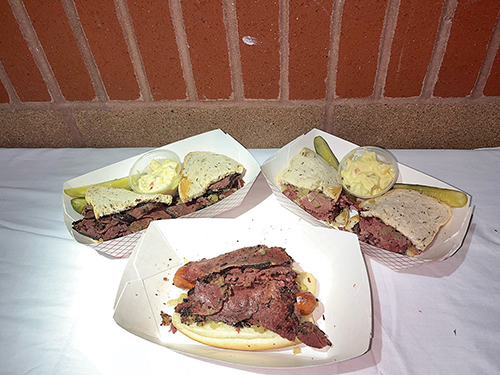
It’s not a large menu, but it’s a strong one. They’re famous for their “killer pastrami” which they serve on top of a hot dog or on bread as a sandwich. They also have corned beef sandwiches and you can order a hot dog on its own if you’re less adventurous. Let’s just say that the pastrami lives up to the hype. It goes well in the sandwich, but getting it on top of the hot dog with your choice of toppings is really the way to go. I’d suggest ordering two because you’ll likely want more than one, but the line gets quite long and you don’t want to miss too much of the game.
As mentioned above, the community in St. Louis might not be the largest, but it’s been there a long time and is firmly established. With six Orthodox shuls, you won’t have trouble finding a minyan if you’re looking for one. Several local supermarkets have kosher sections that might help you stock up before you skip town.

After the game, it’s time to head west, much like the arch would suggest. But we aren’t heading to California or even leaving the state.
If you hop on Interstate-70 West and drive for about 3 1/2 hours, you’ll end up in Kansas City. If you want to break up the drive, try staying halfway between the two cities overnight and finishing the drive in the morning. Columbia is a fairly large city (home to the University of Missouri) that lies directly in the path of the highway and has many options for hotels or Airbnbs.
Due to our itinerary, we are going to be staying on the Missouri side of the border and not actually venturing into Kansas. But the vast majority of the Orthodox community lives in the Kansas suburb of Overland Park. There you can find a minyan at Congregation Beth Israel Abraham and Voliner (BIAV). There are also a host of Chabad shuls in the area that service smaller outlying communities. Much like St. Louis, kosher food is available in expanded kosher sections in a few local supermarkets, but restaurants are limited.
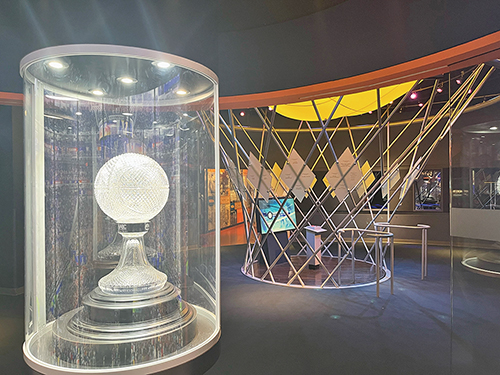
One thing that Kansas City was famous for in the sports world was its having been home to NCAA headquarters from 1973-1999. The National Collegiate Athletic Association has since moved on to Indianapolis, but the NCAA continues its presence in Kansas City by maintaining the College Basketball Experience there. The building is actually divided into two areas, with the majority of the building being devoted to the interactive parts of the experience and the National Collegiate Basketball Hall of Fame being located on the ground floor.
The interactive experience is one of a kind. It looks like a hybrid of a pop-a-shot machine and a rec center. Sure, there’s a full court and a half court, but you’ve seen those before. What you probably haven’t seen are machines that can measure your wingspan, standing reach and vertical leap. Or full-size machines for shooting drills, a wall of hoops that get progressively higher to test your dunking abilities, or interactive targets for passing drills or buzzer-beaters. It’s a paradise for basketball fans of all ages.
The museum downstairs features tributes to the greatest players and coaches throughout history. You can see a diagram of a coaching tree that stretches back to the beginning of college basketball, get a look at the national championship trophy, or check out the plaques of all the legends of the game.
If we are allowing one non-sports mention per city, it should be noted that the College Basketball Experience is in the new Power and Light District of the city. It’s a nice place to walk around, but you can also climb aboard the free KC Streetcar and ride it down to River Market and check out the great selection of shops and stores. You’ll find a bunch of locally crafted items that might make for great souvenirs.

Next stop on our tour of local sporting attractions is the Negro Leagues Baseball Museum. It’s located in the 18th & Vine District of the city that was the center for African American life in Kansas City in the first half of the last century. It actually shares a building with the American Jazz Museum, so take advantage of that if you have the time and desire.The Kansas City Monarchs were probably the greatest Negro League franchise of all time, so it made sense to put the museum here.
The museum highlights the different leagues and eras of segregated baseball as well as everything that went into ending the discrimination. There’s so much history packed into the museum that they are currently fundraising to build a much larger building in the future. Honestly, I could see spending hours upon hours here just reading all the materials and looking at all the photographs and artifacts. The abundance of items and the quality of their current condition will astonish you.
The museum concludes at an indoor baseball diamond with statues of the greatest Negro League player at every position, replete with an umpire and a manager. Walking up to the statues and thinking about what these men would’ve thought if they had known that there would be statues of them one day was a moving experience.
Speaking of baseball teams in Kansas City, it’s time to visit the Royals and Kauffman Stadium. “The K,” as the stadium is often referred to by locals, opened 50 years ago and is possibly in danger of being replaced. This is mostly due to its location outside the city center and a need for luxury boxes, not necessarily the current condition of the ballpark. (It shares a parking lot with the Kansas City Chiefs’ famous Arrowhead Stadium … go grab a picture if you have a minute.) Though those are valid points, I really enjoyed the park and some of the specific attributes.
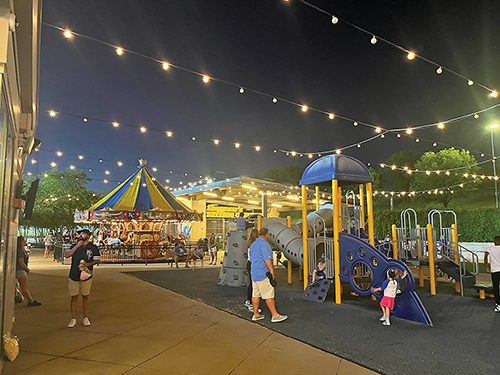
Unlike the Cardinals, the Royals built their hall of fame and museum inside the ballpark. In terms of internal museums, it’s certainly one of the best in baseball. You can find all sorts of great stuff that pays tribute to the more than half century of Royals baseball. Make sure that you stop there as you walk to the outfield to get a look at the famous fountains that are Kauffman’s calling card.
But the most extravagant part of the ballpark is the pavilion behind center field. The Royals call this their Outfield Experience and it’s certainly that. The area features a large playground for kids so that the youngsters who can’t sit still can let off some steam. For those under 4 feet tall, there’s a mini field where sluggers in training can try to hit a ball over the fence and run the bases. If you’re over 4 feet tall, there’s a batting cage with your name on it. Other attractions include a full-size carousel, a timed home-to-first base running challenge, a radar gun to measure your fastball, and a nicely constructed five-hole mini golf course. Even when the stadium isn’t full, there are plenty of people at the Outfield Experience making the ballpark feel like a kind of county fair.
With so much done in so little time, you’re going to have to get some sleep before catching a flight home. But don’t schedule that flight too early because you want to give yourself time to pick up breakfast (and why not lunch for the plane) from Meshuggah Bagels. Not every location is kosher, but they do have a couple of kosher ones, including one that’s in Missouri. They’ve got an array of bagels and schmears as well as whitefish and lox.
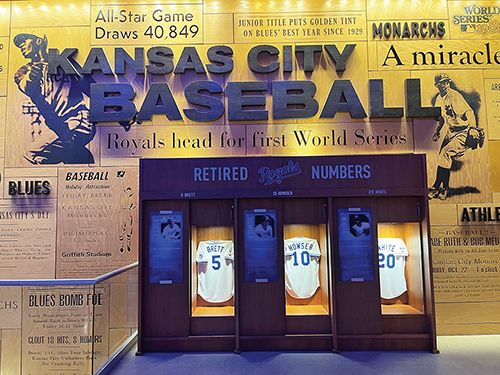
If you have a sweet tooth, their menu can accommodate that trendy avenue (chocolate chip or cinnamon raisin bagels with cinnamon sugar, oreo cheesecake, strawberry or blueberry cream cheeses). I personally grabbed a bialy with whitefish and tomato for breakfast (the dough was perfect and the fish tasted wonderfully smoky and fresh) and an everything bagel with jalapeño cream cheese, red onion, capers and pastrami lox for lunch (the spicy cream cheese went really well with the lox and onions, while the capers brought that perfect salty punch).
It might not be close to the airport, but KC traffic isn’t exactly as bad as other cities you’ve probably been to. Having a real lunch for the plane back is always preferable to landing and needing food when you don’t know how much traffic there is between you and home.
With the whole trip barely eclipsing 48 hours, this isn’t exactly a long road trip. But there’s so much to do when considering the various sports attractions that Missouri has to offer.
Two great baseball stadiums, multiple halls of fame and museums, some nice kosher bites, and one amazing national monument that you just have to see in person to really appreciate …
It sounds like Missouri is the gateway to a great vacation.











